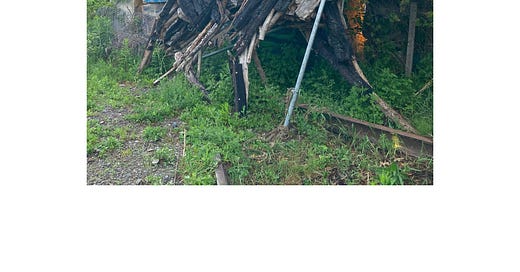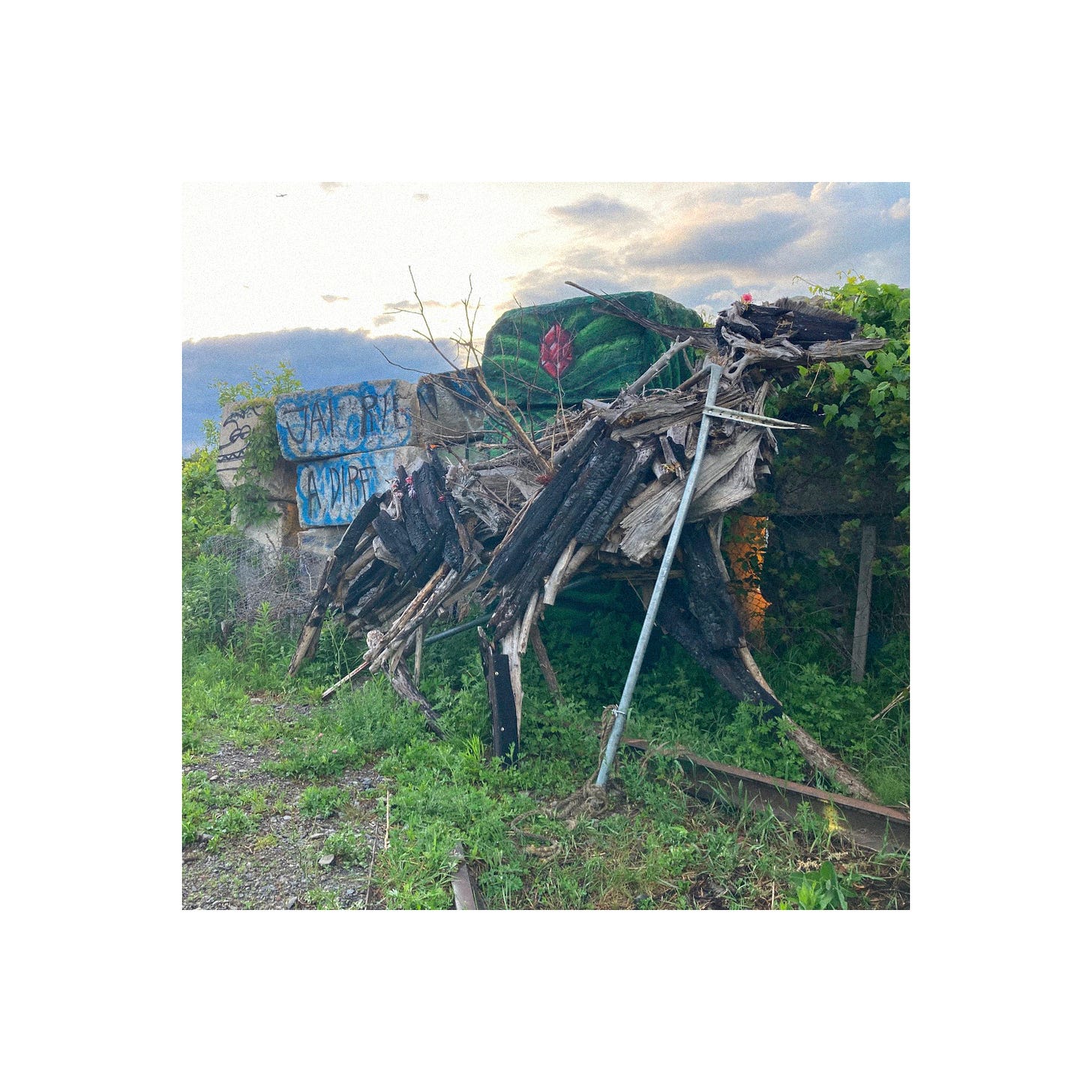Nestled between the working-class Hochelega neighborhood, a port logistics center, and the St. Lawrence River in Southeast Montreal, the Terrain Vague is a green space and commons in the metropolitan desert. For longer than anyone can remember, people have gathered at this spot to celebrate, share food, and enjoy each other’s company. In ways analogous to the South River Forest in Atlanta, this ‘terrain vague’—a technical term that roughly translates as ‘vacant lot’—functions as one of the last real public spaces in Montreal where people can do what they want. A wild and unusual place, as vague as it is beautiful.
It thus surprises no one that over the past few decades, a succession of industrial projects have threatened to crush the territory’s unruly ambiguity—or that the surrounding community has fought back. Most recently, hundreds of people from a variety of social and political backgrounds converged on the space from June 4 to 11 for a series of workshops, circus performances, children’s theatrical plays, and punk shows in a shared effort to keep these woods alive. The problem they sought to solve is a complex one. As some friends recently wrote,
In a space like the terrain vague, the question is not how to preserve the space, but instead, how to use it… It is a place inhabited by all sorts of entities, memories, and futures that force us to face certain contradictions: on the one hand, wanting keep our hands off the few remaining wild spaces in the city and let them run their course; and on the other, the need to mobilize in its defense, to build on it in order to protect it.
It is precisely this openness of the use of the Terrain Vague that pulls so many different living things into its orbit, that makes it what the Zapatistas call “a world in which many worlds fit.”
The week prior to the June gathering, there were several impromptu raves occurring in different corners of the woods. At one point it served as a homeless encampment, until a raid saw police slashing tents and clubbing fleeing people while on horseback despite an insufficient rapid defensive mobilization from friends and comrades in the area. In another section, residents of the adjacent neighborhood have planted a community vegetable garden. Still elsewhere a large metal and wooden statue of an antlered animal spirit created by Junko watches over the entire scene with serene determination. Late at night, groups of friends pass blunts on a hill overlooking metal cargo boxes or pitch tents in spots slated to become roads for commodity circulation. The spot is a known cruising destination. One can never know exactly what is happening at every place in the Terrain all at once, and one never needs to.
It is difficult to separate nature from culture, or to decide where the “human” ends and the “non-human” begins on the Terrain Vague, in part because capital has already smoothed the space over several times. Since the warehouse that used to stand on the site burned down in the 1990s, a truly vague density of plants, animals, and people has sprouted up and formed what some call an “ecology of presence.” Spending time there, one notices small trees and young phragmites reeds that have grown in the rubble since then dotting the landscape and creating a scattered canopy. We were corrected several times for referring to the “forest”—it is in fact only a “woods,” friends insist, the trees young and uncertain of themselves. The passage of time is felt in an immediate and visceral way. One participant at the convergence commented that the young plant life changes so rapidly that after a month's absence, they got lost navigating its shifting footpaths. There is nothing pure about this place, nothing familiar to the liberal environmentalist discourse that sees Nature and the Environment as both intensely sacred and entirely manageable, an occasion for new forms of sustainable capital and an object of planning and anxious “preservation.”
The recent intensification of struggle around this site responds to a competing vision for the Terrain Vague, articulated by developers, industrialists, and energy giants. The adjacent land is used as a storage and transportation facility for Ray-Mont Logistics, a huge international which has previously cut down a patch of trees to lay tracks of rail. For the last few years, the same consortium has been desperately trying to build a road through the remaining woods, despite legal obstacles and community opposition. The defenders of the Terrain Vague have thus far been able to stop many of the projects poised to destroy the heterotopia, but this new conflict may be with the most committed enemy yet.
Ray-Mont Logistics’ scheme forms only a small part of the reconfiguration of capital along the St. Lawrence River in the era of climate catastrophe. As the extent of the disaster becomes evident, business in Canada has shifted toward so-called “green energy,” ramping up regional extraction of lithium and nickel and damming up more of its tributaries for hydropower. Companies along the St. Lawrence, Ray-Mont Logistics among them, support this transition with infrastructure, technology, and more sophisticated policing and surveillance. They seek to crush territories that nurture life beyond accumulation in the process.
HydroQuebec is a major developer in the northwestern James Bay region and central to both Canada and the United States’ climate change response. About half of the company's exports go to New England, providing a substantial amount of the power for New York City. A $6 billion power line transporting hydropower from Quebec to Queens beneath Lake Champlain and the Hudson River is near completion, further cementing Quebec’s place in New England’s Green New Deal. And yet the damming of James Bay and its tributaries is in no way green or even zero emissions, since it results in flooding that destroys boreal forests releasing carbon at levels comparable to a coal plant. All of this has been done over the decades-long protests of the Cree people. Far from a local struggle, the Terrain Vague has the potential to connect people over thousands of miles and across borders, in a struggle to disrupt this colonial plan for “sustainability.”
In addition to the growth of hydropower, industry’s “green” vision for the province includes the unimpeded plundering of natural resources in the north, a region mainly inhabited by indigenous peoples. Over 300 miles northwest of Montreal, near La Corne, there is a lithium mine on Anishinabeg territory, a project which has already caused two wastewater spills. In another case, a lithium deposit in the James Bay region is scheduled to be mined by 2025. The Cree community of Nemaska has pushed back against the plans, given that the mine will dry up surrounding bodies of water and continue to poison populations of fish that are already contaminated with mercury from previous projects by the same company. Only a few weeks before the convergence at the Terrain Vague, members of the Atikamekw set up multiple blockades to stop logging on their lands.
The Montreal port, where the Terrain Vague is located, is a crucial node in the chain of resource extraction, intimately linking it to the struggle by indigenous people for control of their lands. Since Ray-Mont Logistics has threatened the Montreal woods over the past four years, land defenders have used a wide array of tactics honed during solidarity with indigenous struggles to push back against the project. This has included frequent rail and road blockades to shut down operations and construction at the adjacent industrial hub. Militants have erected flaming barricades on the train tracks, stopping the flow of goods and destroying construction equipment. Mothers from Hochelega wake up early and stand in front of trains holding banners reading resister et fleurir, a quick stop before they drop their children off at school. Neighborhood residents engage in planting projects and attend city council meetings, signing petitions and pressuring politicians to stop the construction. Actions grow partially out of the petitioning effort and the Facebook group that it spawned, “Mobilisation 6,600,” a reference to the number of signatures from Hochelega residents.
The autonomous network that has mobilized to defend the Terrain Vague can be seen as an example of the strategy of composition. Forest defenders include families from Hochelega, nomadic punk kids, university students and professors, ravers, leftist environmental activists, anarchists, and many more. Members of the Mohawk People have visited and Wet’suwet’en tribal members have come to the Terrain Vague to present on their struggle against pipeline construction in British Columbia. The heterogenous movement goes beyond a simple diversity of tactics and instead has begun to coordinate the struggle’s many fronts for greater tactical effect. At the same time, there is no room for domination by any one organization, since even if one belongs to a formal group, desires and attachments on the ground are much more significant than abstract affiliations and ideologies.
Unlike the out of touch depiction of environmental activism in the film How to Blow Up a Pipeline, all of these tactics—from the institutional to the most confrontational—have grown out of a vibrant collective struggle for a space that is inseparable from the people who use it. It is common to hear the Hochelaga mothers say that burning equipment is not violence, that instead destroying trees to build a road is violence. This shared perception between groups was not a given at the start of the struggle, rather it was arrived at by years of building trust through collective action. The result has been the opening up of a wide field of play and experimentation in the Terrain Vague that encourages new relationships and strong commitments.
There is much in this story that reminds us of the ongoing struggle to defend Atlanta’s Weelaunee Forest. Both are redefining contemporary ecological struggle in the US and Canada, weaving dense networks that draw strength from difference in the process. As we continue the fight to protect the Weelaunee Forest from becoming a police training facility, we call for a proliferation of places where ungovernable worlds boil over, multiplying their contact with one another and the land. We call for a world made up entirely of such places, places without police, places where the forest wins in the end.
CORRECTION: Please note that a prior edition of this article misrepresented the struggle’s composition, extending it to the Mohawk People and the Wet’su’weten Tribe. As several readers helpfully pointed out, indigenous supporters of the struggle have only visited and presented, and have not been as involved as other participants. We apologize and take full responsibility for this miscommunication.





